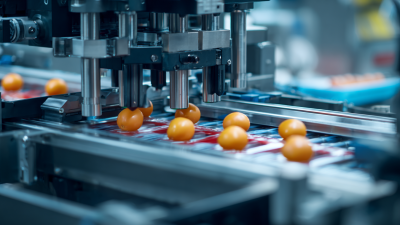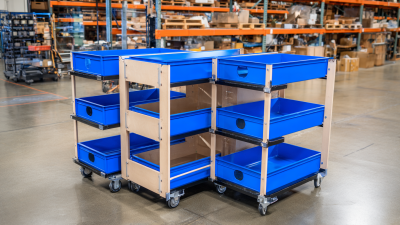Exploring the Future of Conveyor Systems in Automation and Smart Manufacturing
As the landscape of automation and smart manufacturing evolves, conveyor systems remain a critical component in enhancing operational efficiency and productivity. Recent reports indicate that the global conveyor systems market is projected to reach approximately $7.61 billion by 2026, growing at a CAGR of 4.85% from 2021 to 2026. This growth is driven by the increasing demand for automated solutions in various industries, including logistics, automotive, and food processing. Advanced conveyor systems, equipped with IoT technology and AI capabilities, provide real-time monitoring and data analytics, enabling manufacturers to optimize workflow and reduce downtime. As businesses seek to streamline production processes and enhance supply chain management, the integration of smart conveyor systems will be essential in shaping the future of manufacturing.

This article explores the innovative developments and applications of conveyor systems in the realm of automation, offering insights into best practices and future trends within this dynamic industry.
The Rising Demand for Smart Conveyor Systems in Automated Manufacturing Environments
The demand for smart conveyor systems is rapidly increasing in automated manufacturing environments as industries seek to enhance efficiency and productivity. These advanced systems are designed to integrate seamlessly with existing manufacturing processes while incorporating cutting-edge technologies such as
artificial intelligence, IoT, and data analytics. By utilizing smart conveyors, manufacturers can optimize the flow of materials and products, reducing bottlenecks and improving throughput.
Additionally, the implementation of smart conveyor systems allows for real-time monitoring and predictive maintenance, minimizing downtime and operational costs. These systems can adapt to various product types and sizes, promoting flexibility in manufacturing lines. As the industry shifts towards customization and rapid response to market demands, the role of smart conveyors becomes crucial, ensuring that production processes are not only efficient but also responsive to changing needs. The growth of smart conveyor systems is expected to redefine manufacturing capabilities, making it an essential component of the future of automation.

Integration of IoT Technologies in Conveyor Systems for Enhanced Operational Efficiency
The integration of IoT technologies in conveyor systems is revolutionizing automation and smart manufacturing, significantly enhancing operational efficiency. Recent reports indicate that the global market for IoT in manufacturing is expected to reach $357 billion by 2025, reflecting a compound annual growth rate (CAGR) of 23.1%. This surge is primarily driven by the need for real-time data analysis and predictive maintenance, allowing manufacturers to streamline processes and reduce downtime.
IoT-enabled conveyor systems facilitate seamless connection between machinery and operators, providing real-time analytics on performance metrics such as speed, load, and predictive failure. According to a study by McKinsey, manufacturers who adopt IoT technologies can expect an operational efficiency increase of up to 30%, translating into significant cost savings and improved output. With the increasing complexity of manufacturing environments, the integration of smart technology into conveyor systems is paramount for a competitive edge in the industry. This technological evolution not only optimizes the supply chain but also fosters a more agile production process, paving the way for the future of intelligent manufacturing.
Analyzing the Role of AI and Machine Learning in Conveyor System Optimization
The integration of AI and machine learning into conveyor systems is reshaping the landscape of smart manufacturing. By enhancing the efficiency of warehouse management, AI automates workflows, minimizes errors, and optimizes inventory in real time. For instance, AI-driven optimization techniques are pivotal in increasing throughput and reducing operational costs in logistics. According to recent studies, automating logistics fulfillment processes with robotic systems and AI not only boosts productivity but also allows for greater adaptability in varying demand scenarios.
Moreover, the conveyor belt market is experiencing significant growth, driven by advancements in smart technologies. The market is expected to increase from USD 31.23 million in 2024 to USD 50.44 million by 2033 in the Philippines alone. This growth can be attributed to the demand for more efficient material handling solutions, showcasing how innovative conveyor systems can improve overall supply chain dynamics. As industries further explore AI applications, we can anticipate continued advancements in conveyor system optimization that will propel automation and smart manufacturing into a new era.
Exploring the Future of Conveyor Systems in Automation and Smart Manufacturing
| Dimension | Description | Current Trends | Future Outlook |
|---|---|---|---|
| System Efficiency | The effectiveness of conveyor systems in throughput and speed. | Integration of AI for predictive maintenance and real-time monitoring. | Use of advanced algorithms to enhance operational efficiency and minimize downtime. |
| Flexibility | The ability to adapt to changing production requirements. | Modular conveyor designs with automated adjustment features. | Implementation of smart systems that can be rapidly re-configured. |
| Data Utilization | The use of data analytics for improving performance. | Real-time data collection and analysis for decision-making. | Enhanced AI-driven insights for predictive analytics. |
| Safety Features | Mechanisms to ensure the safety of workers and equipment. | Integration of sensors and automation for safety compliance. | Advanced safety protocols driven by machine learning analysis. |
| Sustainability | Impact on energy use and environmental footprints. | Development of energy-efficient conveyor systems. | Use of sustainable materials and reduction in waste through optimization. |
Future Trends: Sustainability and Energy Efficiency in Conveyor System Design
As the manufacturing industry evolves, the integration of sustainability and energy efficiency into conveyor system design is becoming increasingly vital. Future trends indicate that companies will prioritize eco-friendly materials and energy-saving technologies in their conveyor systems. By adopting advanced designs that minimize energy consumption, manufacturers can significantly reduce their carbon footprint while maintaining optimal efficiency.
Tip: Consider investing in conveyor systems that utilize regenerative drives, which can capture and reuse energy during operation. This not only enhances energy efficiency but can also lead to substantial cost savings in the long run.
Another significant development in conveyor system design is the automation of processes to reduce waste and streamline operations. Smart manufacturing approaches often incorporate IoT technologies, enabling real-time monitoring and adjustments that facilitate sustainable practices. As industries embrace digital transformation, the need for adaptive systems that can optimize energy usage will increase, making sustainability a core component of conveyor technology advancements.
Tip: Regularly assess your conveyor system's performance data to identify areas for improvement in energy consumption. Implementing predictive maintenance strategies can help you avoid downtime and ensure that your systems run at peak efficiency.
Market Growth Projections for Automated Conveyor Systems in Various Industries
The market for automated conveyor systems is poised for significant growth across various industries, reflecting the broader trends of automation and smart manufacturing. As companies increasingly recognize the benefits of integrating advanced conveyor systems into their operations, sectors such as e-commerce, automotive, and pharmaceuticals are leading the charge. The demand for efficiency, reduced labor costs, and enhanced productivity is propelling investments in technologies that streamline material handling and logistics.

Moreover, the advent of Industry 4.0 is driving innovation in conveyor technologies. Businesses are starting to adopt smart conveyor systems that utilize IoT features, enabling real-time monitoring and data analytics to optimize workflows. This shift not only improves operational efficiencies but also facilitates a more agile manufacturing environment where supply chains can swiftly adapt to market changes. As industries continue to evolve, the role of automated conveyor systems is expected to become even more critical, solidifying their presence in the future landscape of manufacturing solutions.
Related Posts
-

Revolutionizing the Food Industry How Food Packaging Machines Enhance Freshness and Sustainability
-

Revolutionizing Packaging: How Automatic Bagging Machines Enhance Efficiency and Precision in Industries
-

Transform Your Workspace: The Ultimate Guide to Selecting the Perfect Material Handling Carts
-

The Essential Guide to Choosing the Best Material Handling Carts for Your Business Needs
-

Innovative Material Handling Carts for Efficient Workplace Organization and Productivity
